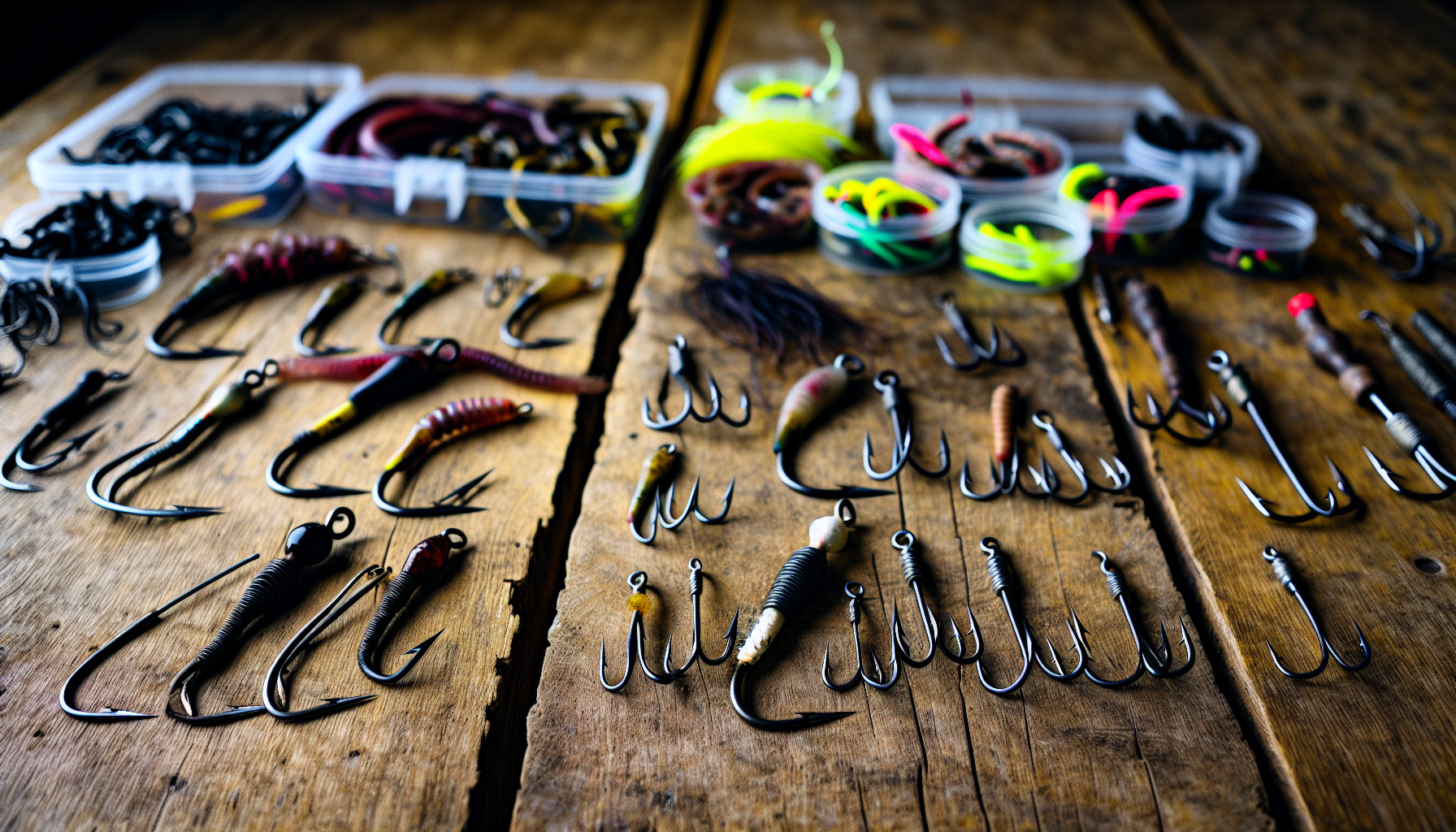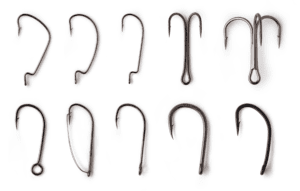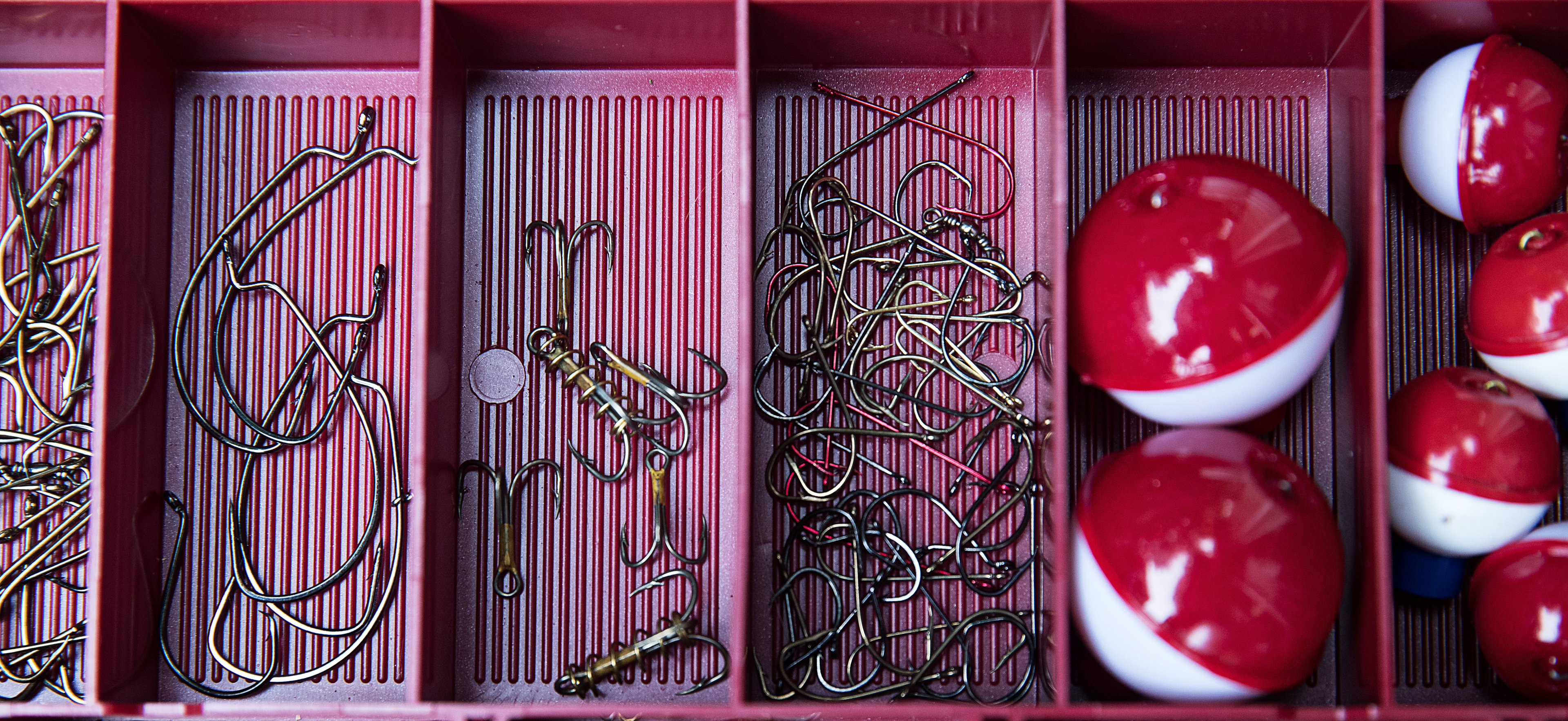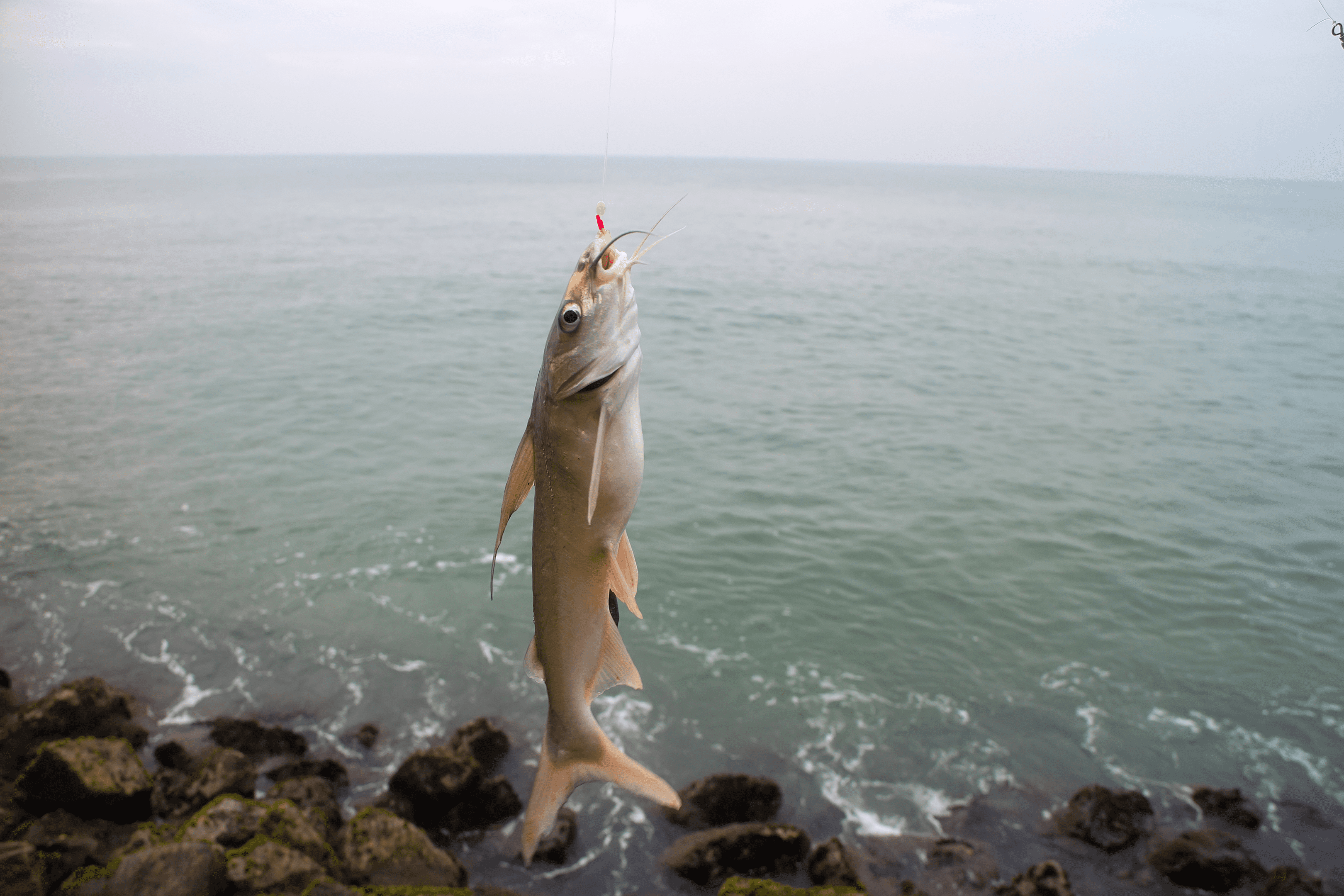Choosing the Best Hook Size for Surf Fishing Success
Selecting the proper hook size for surf fishing ensures your hooks aren’t too big to be swallowed, or too small to catch your desired fish. This guide zeroes in on the key information you need, delivering no-frills advice on the right hook size for various fish and bait in surf conditions. Get ready to optimize your tackle and boost your catch rates with strategic hook sizing.
Key Takeaways
- Choosing the appropriate hook size is critical for surf fishing success and should be based on the target fish species and bait used, with hook sizes varying inversely for small hooks (#32 to #1) and directly for large hooks (1/0 to 19/0).
- Different types of hooks—circle hooks, J-hooks, baitholder hooks, and treble hooks—are designed for various bait types and fishing techniques, with circle hooks being ideal for live bait and reducing gut hooking.
- Effective surf fishing requires matching your hook to your bait—small hooks for small live baits, appropriate sizes for cut bait, and J-hooks for artificial lures—and employing the right hook setting technique, especially with circle hooks requiring a steady reel in and J-hooks needing a sharp strike.
Understanding Hook Sizes for Surf Fishing

To the uninitiated, a hook may seem like a simple piece of metal. But ask any seasoned surf anglers, and they’ll tell you − it’s an art to choose the right hook size. Your surf fishing success largely depends on the hook size, which should be selected based on the target fish species and the choice of bait used.
Many surf anglers believe that understanding the fish species at your chosen surf fishing spot and their feeding habits is a good starting point to determine suitable hook sizes. Thus, selecting the correct hook size is crucial, whether you’re targeting a small croaker or a large shark.
Hook Size Measurements
Hook size measurements are not as straightforward as you might think. There are two systems of hook size measurements – a bit of a quirk of the fishing world. For smaller hooks, the numbering system is inverse, meaning higher numbers indicate smaller sizes. The sizes range from #32 (the smallest) down to #1.
When it comes to larger hooks, the numbering system is direct, starting from 1/0 (pronounced “one aught”) up to a massive 19/0, with higher numbers representing larger hooks. Whether you’re dealing with a minuscule #32 hook or a gigantic 19/0, mastering these measurements is essential for successful surf fishing.
Target Fish Species
Now, let’s dive a bit deeper into the sea and look at some specific fish species and the recommended hook sizes for them. Here are the recommended hook sizes for different fish species:
- For smaller species like croaker and ladyfish, hook sizes 2/0 and 1/0 are ideal.
- If you’re targeting larger surf sharks and big rays, you might want to go with hook sizes of 8/0 or 10/0.
- Circle hooks in sizes 2/0-4/0 are suitable for cut bait depending on the target species.
If you’re looking to present smaller baits like shrimp pieces or sand fleas, a 1/0 or #1 size is perfect. Bear in mind that successful surf fishing involves matching the hook size to both the fish and the bait.
Types of Hooks for Surf Fishing Success

Now that you understand hook sizes, let’s familiarize you with the various types of hooks that can enhance your surf fishing success. From circle hooks to J-hooks, each one has its unique design and purpose that cater to different sizes and species of fish.
Circle hooks, with their straight shank and inward-pointing hook point, reduce the risk of gut hooking and ensure a high hook-up ratio. On the other hand, J-hooks are favored for their aggressive hook setting ability, especially useful when targeting species that attack bait with force. In this context, Eagle Claw kahle hooks can be considered as an alternative option for anglers.
Baitholder hooks, with small metal barbs on the shank, are ideal for surf fishing with soft natural fresh bait.
Circle Hooks
Circle hooks have gained popularity among surf anglers due to their unique design and benefits. The roughly circular pattern of these hooks, due to their distinctive curved shape, is effective for securely catching fish and reducing gut hooking, thus enhancing fish survival upon release. High-carbon steel circle hooks are favored in surf fishing due to their corrosion resistance and strength, making them less prone to rusting and breaking.
For medium-sized live baits, octopus hooks like Inline Octopus circle hooks are recommended, while for larger live baits, Owner Mutu Light Circle Hooks in sizes 4/0 to 8/0 are advised.
J-Hooks
J-hooks are another top choice among surf anglers, known for their versatility and effectiveness. They are suitable for catching a variety of species like Spanish mackerel, surf perch, and saltwater bass, to name a few. These hooks are especially effective for actively fished lure or artificial bait setups, allowing the angler to feel the bite and set the hook promptly.
Moreover, in clear water conditions, J-hooks provide a less conspicuous presentation compared to other hooks like circle hooks, making them beneficial where fish visually inspect the bait.
Baitholder Hooks
If you’re planning to use soft natural baits, baitholder hooks are your best bet. They have the following advantages:
- Equipped with small barbs on a long shank, these hooks keep your bait securely in place during surf fishing.
- They are easier for beginners to grip.
- They are designed to minimize bait loss.
- They are generally simpler to remove.
Especially for novice surf anglers, fish hook baitholder hooks are valuable for maintaining bait fish on the hook during the casting process and decreasing the chances of bait loss.
Treble Hooks
Last but not least, let’s discuss treble hooks. Characterized by their three sharp points, these hooks are suitable for use with artificial lures like plugs, spoons, and spinners actively fished in surf casting. Their multiple points of contact make them preferred for surf fishing when using larger lures that mimic baitfish, thereby increasing the likelihood of hooking a fish during its strike.
While treble hooks increase the efficacy of lures in surf fishing, anglers should be cautious of gut hooking and consider using barbless trebles or replacing treble hooks with single hooks to minimize harm to the fish.
Matching Hook Size with Bait Selection

With a solid understanding of hook sizes and types, we can now explore how to align the hook size with your chosen bait. This is a crucial aspect of surf fishing as the effectiveness of your hook is largely determined by whether it is appropriately matched to the bait size and type.
Whether you’re using live bait, cut bait, or artificial lures, the right combination of hook size and bait can greatly enhance your success rate.
Live Bait
For live baits like fish (bunker heads, ladyfish, bluerunners), squid, and crab, size 4/0 to 8/0 circle hooks are recommended. For hooking baitfish hook the bait through the lips vertically or near the tail horizontally as this allows for natural movement and effective corner-of-the-mouth hookups. For crabs, hooking them on the back corner of their shell behind the claws is perfect for keeping them looking natural. Baitholder hooks are well-suited for live baits such as shrimp, and the addition of light bait elastic can help secure the bait during casting and avoid it being stripped by small fish or crabs.
If you’re using small live baits like sand fleas, shrimp, and small baitfish, suitable hook sizes are 1/0, 2/0, and #1, which help keep the bait alive and allow for natural movement.
Cut Bait
When it comes to cut bait, the proper hook size is crucial for successful catch rates in surf fishing. Here are some guidelines for hook sizes based on the type of cut bait you’re using:
- Bunker heads: 3/0 to 4/0 hook size
- Smaller baitfish chunks: 2/0 or 3/0 octopus-style circle hook
- Half a surf clam: 2/0 or 3/0 circle hook
- Whole clam: 4/0 or 5/0 hook
Using the appropriate hook size will increase your chances of a successful catch. If you are doubting the size hook you should use, lean on the smaller side, if the hook is too big for the target species, hook ups will be very difficult.
Artificial Lures
If you prefer artificial lures, small J hooks are particularly effective. These hooks are suitable for artificial grubs and soft plastics, proving to be suitable for surf perch. The key is to ensure that the hook size is appropriate for the size of the lure and fish you are targeting, ensuring that the hook is likely to snag the fish when lured in.
Hook Setting Techniques for Surf Fishing

Next, we’ll explore the techniques of setting hooks in surf fishing. How you set your hook can make a huge difference to your fishing success. Depending on the type of hook you’re using, there are different techniques you should employ.
Circle Hooks
Setting circle hooks requires a bit of a counter-intuitive approach. Instead of attempting to set the hook with a striking motion, you should reel in steadily when a bite is detected. This allows the hook to catch securely in the corner of the fish’s mouth, which is crucial for successful catch-and-release practices.
Patience is key with circle hooks. Set the hook prematurely, and you might miss your catch.
J-Hooks
Setting J-hooks, on the other hand, requires a strong and deliberate pulling motion to ensure the hook penetrates the tough mouths of larger fish species encountered in surf fishing. These hooks are particularly advantageous when targeting species like bluefish or striped bass, which require an immediate and firm hookset due to their aggressive and quick biting behavior.
To properly execute the strike technique for J-hooks in surf fishing, the angler should quickly retrieve any slack line and then perform a solid, sharp lift or horizontal sweep of the rod.
Treble Hooks
When it comes to treble hooks, a firm and steady pull of the rod is recommended for maximum hook-up success. Avoid a violent strike when setting treble hooks as it reduces the risk of pulling the hooks out of the fish’s mouth.
This steady pulling motion ensures that at least one of the three hook points will catch, increasing your chances of a successful catch.
Barbed vs. Barbless Hooks in Surf Fishing


Moving onto another important aspect of hook selection, let’s assess the positives and negatives of using barbed and barbless hooks in surf fishing. Barbless hooks are favored for catch-and-release practices as they reduce injury to fish and facilitate a quick release. On the other hand, barbed hooks have a small backward-facing projection that aids in securing the fish once hooked.
Your choice between barbed and barbless hooks should consider not only your fishing goals but also local regulations and conservation practices.
Local Regulations and Conservation Practices
On the topic of regulations and conservation, it’s essential to abide by local rules and guidelines when surf fishing. From hook restrictions to slot limits, adhering to local regulations is part of responsible angling. Some regions even require the use of specific hooks like inline circle hooks when targeting certain species like striped bass and sharks.
Make sure to verify any local hook restrictions and consider conservation practices like catch-and-release to ensure an ongoing surf fishing success and responsibly catch fish using the right hook fish techniques.
Tips for Organizing Your Tackle Box
To conclude our discussion on surf fishing hooks, let’s consider some practical aspects. A well-organized tackle box can make your surf fishing experience much smoother and more enjoyable. Choose a tackle box or bag that suits the type of fishing you do, such as a backpack-style tackle bag for shoreline fishing, or a tackle box with clear, waterproof trays for boat or kayak fishing.
Organize your tackle by species, using adjustable dividers in your tackle trays to match lure sizes and maximize storage space efficiently.
Summary
In conclusion, choosing the right hook size and type, matching it with the right bait for your target species, and setting it correctly can make a huge difference in your surf fishing success. Whether you’re a beginner or a seasoned surf angler, understanding the intricacies of hooks can significantly improve your catch rates and overall fishing experience.
So, the next time you’re getting ready for a surf fishing adventure, remember the lessons you’ve learned here. Not every fishing trip will be a successful one, but with the right knowledge and technique, you’ll be one step closer to landing that dream catch. Now, grab your tackle box, hit the beach, and let the surf be your guide.
Frequently Asked Questions
What is the best rig for surf fishing?
The fish finder rig is widely considered the best rig for surf fishing because it provides stability in rough conditions and can hold the presentation on the bottom in deeper water or current. Try using a heavier 3-4oz pyramid sinker for added stability.
What size hook for surf shark fishing?
For surf shark fishing, use a 5/0 to 8/0 circle hook for sharks in the 3-5 foot range. For larger sharks, opt for a 12/0-14/0 circle hook to prevent bending or breaking.
What is the best hook for saltwater fishing?
The best hook for saltwater fishing is subjective, but some top brands to consider are Mustad, Owner, Gamakatsu, VMC, and Eagle Claw, all of which offer a variety of styles and materials to choose from. Keep in mind the specific needs of your fishing situation when selecting a hook.
Do you set the hook when surf fishing?
Yes, setting the hook is crucial in surf fishing because it ensures the hook is securely set in the fish’s mouth, increasing the chances of catching fish. So, it’s an important step to master for successful surf fishing.
What are the different types of hooks used in surf fishing?
In surf fishing, you can use circle hooks, J-hooks, baitholder hooks, and treble hooks to catch different types of fish. These hooks offer versatility for varying fishing conditions.





